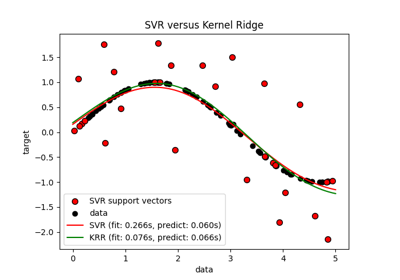KernelRidge#
- class sklearn.kernel_ridge.KernelRidge(alpha=1, *, kernel='linear', gamma=None, degree=3, coef0=1, kernel_params=None)#
核岭回归。
核岭回归(KRR)结合了岭回归(线性最小二乘法与l2范数正则化)和核技巧。因此,它在由各自核和数据诱导的空间中学习一个线性函数。对于非线性核,这对应于原始空间中的非线性函数。
KRR学习到的模型形式与支持向量回归(SVR)相同。然而,使用了不同的损失函数:KRR使用平方误差损失,而支持向量回归使用epsilon不敏感损失,两者都结合了l2正则化。与SVR相比,拟合KRR模型可以以闭合形式完成,并且对于中等大小的数据集通常更快。另一方面,学习到的模型是非稀疏的,因此在预测时比SVR慢,SVR在epsilon > 0时学习稀疏模型。
该估计器内置支持多变量回归(即,当y是形状为[n_samples, n_targets]的二维数组时)。
更多信息请参阅 User Guide 。
- Parameters:
- alphafloat or array-like of shape (n_targets,), default=1.0
正则化强度;必须为正浮点数。正则化改善了问题的条件并减少了估计的方差。较大的值指定更强的正则化。 Alpha对应于其他线性模型中的
1 / (2C),例如LogisticRegression或LinearSVC。如果传递了一个数组,则假定惩罚是特定于目标的。因此它们必须数量对应。请参阅 岭回归和分类 获取公式。- kernelstr or callable, default=”linear”
内部使用的核映射。此参数直接传递给
pairwise_kernels。 如果kernel是字符串,则必须是pairwise.PAIRWISE_KERNEL_FUNCTIONS中的度量之一或 “precomputed”。 如果kernel是 “precomputed”,则假定 X 是核矩阵。 或者,如果kernel是可调用函数,则它在每对实例(行)上调用,并记录结果值。可调用函数应接受 X 中的两行作为输入,并返回相应的核值作为单个数字。这意味着不允许来自sklearn.metrics.pairwise的可调用函数,因为它们操作矩阵,而不是单个样本。请改用标识核的字符串。- gammafloat, default=None
RBF、拉普拉斯、多项式、指数chi2和sigmoid核的Gamma参数。默认值的解释留给核;请参阅sklearn.metrics.pairwise的文档。其他核忽略此参数。
- degreefloat, default=3
多项式核的度数。其他核忽略此参数。
- coef0float, default=1
多项式和sigmoid核的零系数。其他核忽略此参数。
- kernel_paramsdict, default=None
作为可调用对象传递的核函数的附加参数(关键字参数)。
- Attributes:
- dual_coef_ndarray of shape (n_samples,) or (n_samples, n_targets)
核空间中权重向量的表示
- X_fit_{ndarray, sparse matrix} of shape (n_samples, n_features)
训练数据,这也是预测所必需的。如果 kernel == “precomputed”,这将是预计算的训练矩阵,形状为 (n_samples, n_samples)。
- n_features_in_int
在 fit 期间看到的特征数量。
Added in version 0.24.
- feature_names_in_ndarray of shape (
n_features_in_,) 在 fit 期间看到的特征名称。仅当
X具有全部为字符串的特征名称时定义。Added in version 1.0.
See also
sklearn.gaussian_process.GaussianProcessRegressor提供自动核超参数调优和预测不确定性的高斯过程回归器。
sklearn.linear_model.Ridge线性岭回归。
sklearn.linear_model.RidgeCV内置交叉验证的岭回归。
sklearn.svm.SVR接受多种核的支持向量回归。
References
Kevin P. Murphy “Machine Learning: A Probabilistic Perspective”, The MIT Press chapter 14.4.3, pp. 492-493
Examples
>>> from sklearn.kernel_ridge import KernelRidge >>> import numpy as np >>> n_samples, n_features = 10, 5 >>> rng = np.random.RandomState(0) >>> y = rng.randn(n_samples) >>> X = rng.randn(n_samples, n_features) >>> krr = KernelRidge(alpha=1.0) >>> krr.fit(X, y) KernelRidge(alpha=1.0)
- fit(X, y, sample_weight=None)#
拟合核岭回归模型。
- Parameters:
- X{array-like, sparse matrix},形状为 (n_samples, n_features)
训练数据。如果 kernel == “precomputed”,则这是一个预计算的核矩阵,形状为 (n_samples, n_samples)。
- yarray-like,形状为 (n_samples,) 或 (n_samples, n_targets)
目标值。
- sample_weightfloat 或 array-like,形状为 (n_samples,),默认=None
每个样本的个体权重,如果传递 None 则忽略。
- Returns:
- selfobject
返回实例本身。
- get_metadata_routing()#
获取此对象的元数据路由。
请查看 用户指南 以了解路由机制的工作原理。
- Returns:
- routingMetadataRequest
MetadataRequest封装的 路由信息。
- get_params(deep=True)#
获取此估计器的参数。
- Parameters:
- deepbool, 默认=True
如果为True,将返回此估计器和包含的子对象(也是估计器)的参数。
- Returns:
- paramsdict
参数名称映射到它们的值。
- predict(X)#
使用核岭模型进行预测。
- Parameters:
- X{array-like, sparse matrix},形状为 (n_samples, n_features)
样本。如果 kernel == “precomputed”,这则是一个预计算的核矩阵,形状为 [n_samples, n_samples_fitted],其中 n_samples_fitted 是用于该估计器拟合的样本数量。
- Returns:
- Cndarray,形状为 (n_samples,) 或 (n_samples, n_targets)
返回预测值。
- score(X, y, sample_weight=None)#
返回预测的决定系数。
决定系数 \(R^2\) 定义为 \((1 - rac{u}{v})\) ,其中 \(u\) 是残差平方和
((y_true - y_pred)** 2).sum(),而 \(v\) 是总平方和((y_true - y_true.mean()) ** 2).sum()。最好的可能得分是 1.0,它可能是负的(因为模型可能任意地差)。一个总是预测y的期望值的常数模型,忽略输入特征,将得到 \(R^2\) 得分为 0.0。- Parameters:
- Xarray-like of shape (n_samples, n_features)
测试样本。对于某些估计器,这可能是一个预计算的核矩阵或一个形状为
(n_samples, n_samples_fitted)的通用对象列表,其中n_samples_fitted是估计器拟合中使用的样本数量。- yarray-like of shape (n_samples,) or (n_samples, n_outputs)
X的真实值。- sample_weightarray-like of shape (n_samples,), default=None
样本权重。
- Returns:
- scorefloat
\(R^2\) 相对于
y的self.predict(X)。
Notes
在调用回归器的
score时使用的 \(R^2\) 得分从 0.23 版本开始使用multioutput='uniform_average'以保持与r2_score默认值一致。 这影响了所有多输出回归器的score方法(除了MultiOutputRegressor)。
- set_fit_request(*, sample_weight: bool | None | str = '$UNCHANGED$') KernelRidge#
Request metadata passed to the
fitmethod.Note that this method is only relevant if
enable_metadata_routing=True(seesklearn.set_config). Please see User Guide on how the routing mechanism works.The options for each parameter are:
True: metadata is requested, and passed tofitif provided. The request is ignored if metadata is not provided.False: metadata is not requested and the meta-estimator will not pass it tofit.None: metadata is not requested, and the meta-estimator will raise an error if the user provides it.str: metadata should be passed to the meta-estimator with this given alias instead of the original name.
The default (
sklearn.utils.metadata_routing.UNCHANGED) retains the existing request. This allows you to change the request for some parameters and not others.Added in version 1.3.
Note
This method is only relevant if this estimator is used as a sub-estimator of a meta-estimator, e.g. used inside a
Pipeline. Otherwise it has no effect.- Parameters:
- sample_weightstr, True, False, or None, default=sklearn.utils.metadata_routing.UNCHANGED
Metadata routing for
sample_weightparameter infit.
- Returns:
- selfobject
The updated object.
- set_params(**params)#
设置此估计器的参数。
该方法适用于简单估计器以及嵌套对象(例如
Pipeline)。后者具有形式为<component>__<parameter>的参数,以便可以更新嵌套对象的每个组件。- Parameters:
- **paramsdict
估计器参数。
- Returns:
- selfestimator instance
估计器实例。
- set_score_request(*, sample_weight: bool | None | str = '$UNCHANGED$') KernelRidge#
Request metadata passed to the
scoremethod.Note that this method is only relevant if
enable_metadata_routing=True(seesklearn.set_config). Please see User Guide on how the routing mechanism works.The options for each parameter are:
True: metadata is requested, and passed toscoreif provided. The request is ignored if metadata is not provided.False: metadata is not requested and the meta-estimator will not pass it toscore.None: metadata is not requested, and the meta-estimator will raise an error if the user provides it.str: metadata should be passed to the meta-estimator with this given alias instead of the original name.
The default (
sklearn.utils.metadata_routing.UNCHANGED) retains the existing request. This allows you to change the request for some parameters and not others.Added in version 1.3.
Note
This method is only relevant if this estimator is used as a sub-estimator of a meta-estimator, e.g. used inside a
Pipeline. Otherwise it has no effect.- Parameters:
- sample_weightstr, True, False, or None, default=sklearn.utils.metadata_routing.UNCHANGED
Metadata routing for
sample_weightparameter inscore.
- Returns:
- selfobject
The updated object.




